Babel (words) by Sidi Larbi Cherkaoui and Damien Jalet at Lincoln Center’s White Light Festival.
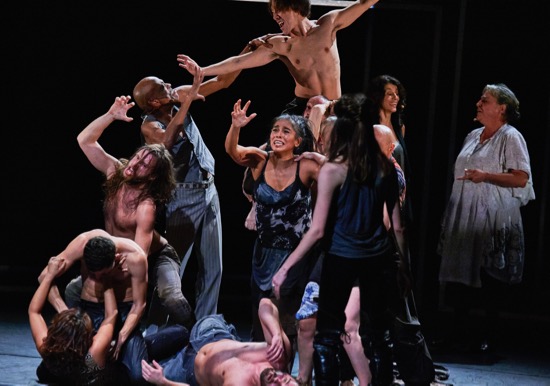
Babel (words) by Sidi Larbi Cherkaoui and Damien Jalet: Visible clockwise from center bottom: Damien Fournier (supine), Paea Leach, Aimilios Arapoglou, Francis Ducharne, Sandra Delgadillo Porcel, Sang-Hun Lee (aloft), Ulrika Kinn Svensson (back to camera), Navala “Niku” Chaudhari, Christine Leboutte. Photo: Robert Altman
Once, according to the King James Bible, all human beings on earth spoke the same language, and when they had found a suitable construction site, they said. “Go to, let us build a city and a tower, whose top may reach unto heaven.” But their God, who famously said, “I the Lord thy God am a jealous God” about rival divinities, wasn’t having that. He was also a nervous God. Therefore, He immediately created many languages so that these ambitious people would have so much trouble communicating that they would fail to collaborate on their venture and would soon scatter over the face of the earth.
Does this tale of what came to be called the Tower of Babel sound relevant to today’s globalization, its virtues and its failures? Think immigration, isolationism, misunderstandings owing to cultural and language differences. Undoubtedly the eminent Belgian choreographer Sidi Larbi Cherkaoui and his co-choreographer, Damien Jalet, thought about these issues when they created Babel (words). The cast performing this remarkable work in the Frederick P. Rose Hall’s Rose Theater, as part of Lincoln Center’s White Light Festival, consists of dancers from thirteen countries, speaking twenty languages or dialects thereof. The composers and/or musicians and singers can be traced to Italy, India, and Japan. Cherkaoui himself is half Belgian, half Moroccan, and Jalet is both French and Belgian; however Cherkaoui’s roots are in Belgium’s Flemish-speaking population, and Jalet’s are in the nation’s French-language group.
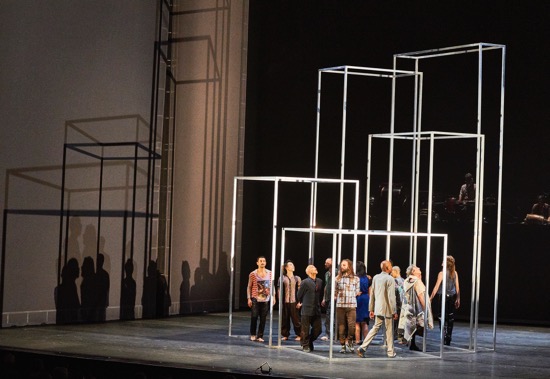
The cast of Babel (words) in Anthony Gormley’s transformable set. Photo: Robert Altman
One of the most prominent features of Babel (words) is its visual design. British artist Anthony Gormley has created five large, open-sided structures of various sizes made of silver rods. One is a cube, and the others are parallelograms, two of them long (tall when set on end) and shallow. Throughout Babel (words), the performers rotate these, tilt them, balance them on a corner, lay them out, slide them through one another, and separate them with fluid ease. These building blocks become tight quarters, prison cells, vehicles, roadways, mazes, and yes, a tower. Adam Carrée’s lighting sometimes throws their shadows on the side walls of the stage.
On a high platform behind them, the composer-musicians Patrizia Bovi, Mahabub Khan, Sattar Khan, Gabriele Miracle, and Kazunari Obe play music on instruments ranging among harp, flute, dulcimer; snare drum, tom, daf, Indian tabla, and Japanese taiko drums; harmonium; mrdangam. A sweet voice may sing out. Fierce percussion may signal changes. Music, unlike words, unites differences.
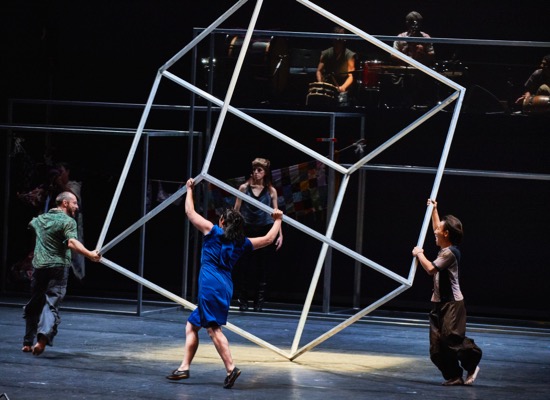
Spinning one of Anthony Gormley’s structures in Babel (words), by Sidi Larbi Cherkaoui and Damien Jalet. (L to R): Damien Fournier, Paea Leach, and Sang-Hun Lee. Standing at back: Ulrika Kinn Svensson. Photo: Robert Altman
There is a narrator of sorts: Tall, dignified Darryl E. Woods frequently addresses us—sometimes venturing into facts about mirror neurons or cultural relations or empathy. And others gesture and talk volubly at one another and to us. From time to time, Kazutomi “Tsuki” Kozuki and musician Kazunari Obe argue, confer, and tell us things in rapid-fire Japanese that make some audience members laugh. Surprisingly, Ulrika Kinn Svensson can give them a brusque little speech in their language. There’s a moment when real babel bursts out, and you hear the din of thirteen voices amid a complementary babble of struggling bodies.
The performers enter gradually to begin kneeling on the floor in a line across the front of the stage; sharply and in immaculate unison, they mark out patterns on the floor with the tips of their fingers, as if marking solitary territory within the group. At a later point, if to emphasize their diversity, they select colorful temporary outfits from a clothesline (costumes by Alexandra Gilbert). There are other times when they express similarity and difference very formally—say, all facing a partner, and the two of them grooming each other with gestural precision. Of course, the way they arrange the structures bespeaks the kind of collaboration that those Tower of Babel builders would have needed in order to build their ambitious abode. But note this: there’s no single arrangement that’s best for Gormley’s architecture; it’s strong, but impermanent.
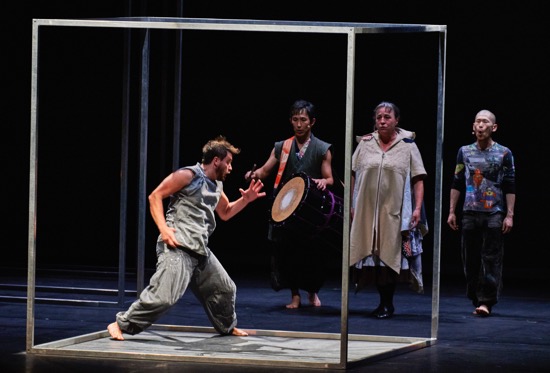
Imprisoned: Helder Seabra. At back (L to R): Kazunari Abe, Christine Leboutte, and Kazutomi “Tsuki” Kozuki. Photo: Robert Altman
There are many striking and provocative moments in Babel (words). The dancers’ ferocious combats build their own snake-pit blueprints. In one vignette, Helder Seabra becomes imprisoned in the cube. We see air between its supports, but he sees walls, and with increasingly desperate strength, beats his elbows, his hands, his body against these invisible surfaces until he’s worn out. As if to break the spell, Benfury simply walks through the cube on his way to somewhere else. In another, more comical scene, Francis Ducharne expounds with casual fervor and in French on getting back to basics. To illustrate his intent, he travels sideways across the stage, getting lower to the ground as he does so. By the time he has reached Svensson’s feet, he has become a hilarious travesty of a caveman—grunting and growling hungrily, sniffing at her. She remains calm, staring over her shoulder at us. Ducharne makes a quick trip back up through the timeline to add something he forgot to tell us, and then it’s back down to inspect Svensson’s breasts and smell her crotch and roar some more.
Svensson plays a somewhat enigmatic character in this. She wears extremely high platform-soled boots than appear to be part of shiny black pants (the tallest person onstage, she must be walking on tiptoe within them) and moves robotically—sometimes watching the others, sometimes working among them. Once two of the men hoist her and move her as if she were a department-store dummy; another time, Kazutomo and (I think) Sang-Hun Lee treat her like an inflatable girlfriend, blowing her up by puffing on her fingers; her cheeks bulge out in response, but the episode ends with her limp and collapsed. Gray-haired Christine Leboutte wears baggy clothes and is given to dusting the structures or the dancers. After a passage that ends with fallen bodies onstage, she sweeps them into recovery.
Amid patterns that suggest eccentric traffic, certain images stand out. Navala “Niku” Chaudhari suddenly hinging backward until her shoulders touch the floor; Benfury, with his break-dance background, flipping across the space; Damien Fournier and Paea Leach (temporarily bare-breasted) sliding and struggling around each other. And all the dancers (that includes Aimilios Arapoglou, and Sandra Delgado Porcel) attract our attention in various ways and at various times. Cherkaoui and Jalet have made sure that they all impress us equally as individuals, as well as being able to merge their distinctive dance backgrounds. And they seem up to every challenge. Near the end of the 90-minute work, most of them start jumping up and dropping to the floor, rising again, jumping, dropping to the floor, rising. . . . They do this to the point of exhaustion.
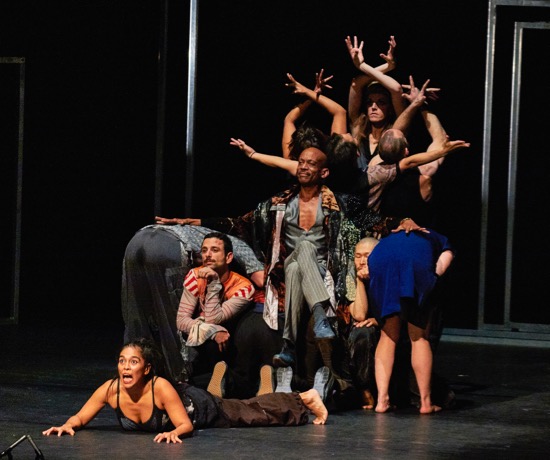
Darryl E. Woods enthroned in Babel (words) by Sidi Larbi Cherkaui and Damien Jalet. Cast with faces visible (L to R low): Sandra Delgado Porcel, Aimilios Arapoglou, Kazutomo “Tzuki” Kozuki. At top: Ulrika Kinn Svensson. Photo: Robert Altman
They also collaborate on a serious of ingenious maneuvers that foreground Woods as a kind of imperialist. The others, clustered behind him, raise an orderly thicket of arms and spread fingers; he could make you think of Lord Shiva and his aura. Then he’s advancing toward the audience, with them behind and beside him; the whole group lumbers slightly, a composite elephant out for walk. Finally, they form themselves into a throne on which he seats himself in a lordly manner.
In one of his talks, Wood’s mentions (not approvingly) that English has become the most widespread language (beginning, perhaps, when Great Britain was a powerful colonizer). Perhaps the script is linking it with the single, pre-Babel language, in which case, it may be good thing to go about demoting it, if that’s possible. Also, can we rely on gestures to communicate when our knowledge of languages fails? In the end, Woods is sitting on the floor, a street beggar with his hand held out. No mistaking that gesture in any part of the world.
Provocative, sensual, comical, terrifying, and more, Babel (words) may bring the audience to its feet through its insights into language, its gorgeous designs, its audacity, and its vibrant performers. But, with luck, it also sends people home thinking.
